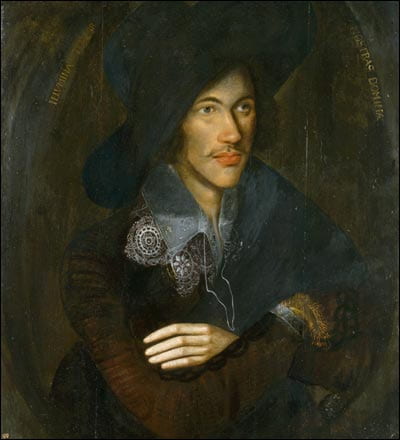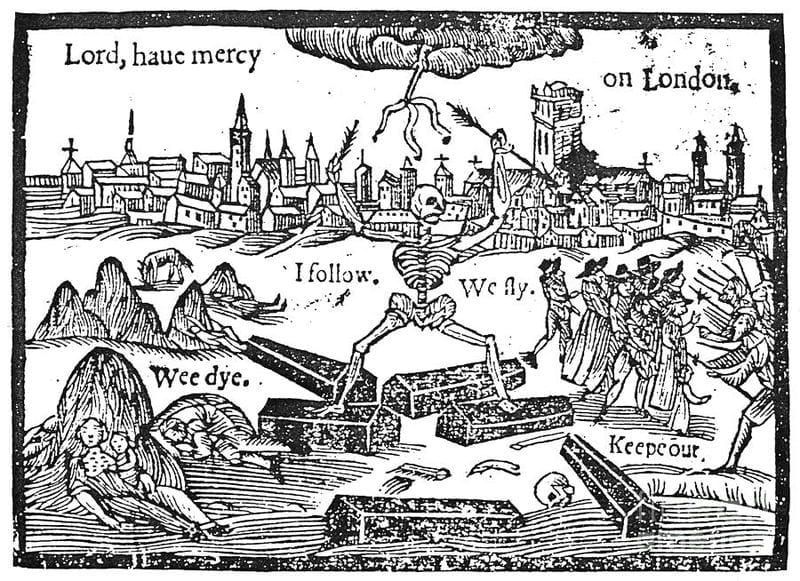By guest contributor Alison Bumke

John Donne, c. 1595. Anonymous painting, National Portrait Gallery London. (Wikimedia Commons)
While John Donne (1572-1631) was writing verse letters and elegies in the early 1590s, London was experiencing a major plague epidemic. His lyrics trace everyday life in a plague-stricken city, describing efforts to identify sources of contagion, disinfect living areas, avoid public spaces, and protect one’s body. They also express the shock of living in a transformed city, where bustling streets are suddenly ‘lancke & thin,’ as he writes in a verse letter, ‘To Mr E. G.’ (l. 9). Donne’s early verse conveys a familiarity with medical theories of contagion that would inform how, decades later, his sermons depicted sin passing through a population.
By the 1590s, the term ‘contagion’ had been used in an English medical context for nearly a century. The period’s medical theorists were undecided, however, on whether contagion had physical substance. Galen, the widely cited Greek physician, believed that it consisted of tiny ‘seeds’ of air, water, and organic matter: a precursor to modern germ theory. These seeds were thought to communicate sickness through the air and via direct contact. At least two English plague tracts, printed during London’s 1603-4 plague epidemic, refer likewise to a ‘corrupt and venemous seede’ of disease. In Italy, meanwhile, a physician and poet named Girolamo Fracastoro proposed the existence of airborne ‘seeds’ of disease in his De contagione (1546). But in early modern England, the prevailing theory of contagion was that miasmas—expanses of foul-smelling air—communicated illness.
Video from the Virtual Paul’s Cross Project, reconstruction of where Donne would have preached. For more information on the sulfurous smoke and gloomy weather of Donne’s weather, see here.
A person inhales infectious air through her nose’s porous lining, Galen argues in his De instrumento odoratus (c. 170). This porous lining is like a sponge: its ‘hollownesse and holes … may take in the smoake that is resolued, and commeth from the thing that is smelled,’ Stephan Batman explains. After the person’s sponge-like nose inhales the ‘smoake,’ or vapour, that an object produces, the vapour proceeds to her brain. By the time her brain perceives its scent, the corrupt air has started to infect her body.
To avoid inhaling corrupt air, the person can fill her nose’s ‘hollownesse and holes’ with sweet scents. Spices and herbs produce pleasing, harmless vapours that fill the nasal passages, preventing putrid air from reaching the brain and infecting the body. The period’s medical tracts recommend carrying scented sachets and pomanders in public, as protection against disease. In Physicall directions in time of plague (Oxford, 1644), for example, an anonymous author urges readers to carry fragrant items when ‘going abroad, or talking with any’. A person should hold a perfumed object in her mouth or hand so she inhales its vapours, rather than putrid air. Medical tracts recommend also using spices to perfume rooms, indoor fires, and cleansing water. In A dialogue bothe pleasaunte and pietifull (London, 1564), William Bullein writes, ‘Forget not to kepe the chamber, and clothyng cleane, no priues at hande, a softe fire with perfumes in the mornyng.’ Perfuming homes with pleasing, innocuous scents reduces the inhabitants’ risk of inhaling corrupt air.
Donne’s early verse alludes to medical tracts’ guidelines for avoiding putrid vapours. His poem ‘The Anagram’ mentions two of the spices Physicall Directions lists: musk and amber. He writes,
In buying things perfum’d, we aske; if there
Be muske and amber in it, … (ll. 13-4)
Potential buyers ask if perfumed objects contain strongly scented spices, like musk and amber, to determine if the objects will block corrupt air’s scent. In addition to masking putrid odours, individuals could attempt to purify corrupt air. Bradwell’s A watch-man for the pest (London, 1625) advises firing cannons, so air is ‘first forcibly moved, shaken, divided and attenuated, and so prepared for purification; & then immediately (by the heat of the fire) purified.’ Alternatively, he recommends leading a ‘great drove’ of oxen through an infected city so ‘their sweet wholsome breath’ can ‘cleanse the impure Aire.’ Donne refers to the former method in his poem, ‘The progress of the soul, Metempsychosis.’ ‘Thinner than burnt air flies this soul,’ he writes (l. 173). Cannon fire burns away air’s impurities, so the resulting, ‘burnt’ air is thinner than average.
Attempts to purify or mask corrupt air had limited success, however. ‘In every street / Infections follow, overtake, and meet,’ Donne writes in 1592 in a verse letter, ‘To Mr T. W.’ (ll. 9-10). A major plague epidemic was starting in London, and it would ‘overtake’ tens of thousands by 1594. The concept of contagions having physical heft—enabling them to ‘follow’ an individual—appears often in contemporary medical tracts. Thomas Dekker, for example, writes in 1603 that ‘thick and contagious clowdes’ of infection have ‘driven’ some individuals out of their ‘earthlie dwellings,’ or bodies, while others have avoided the ‘arrowes’ of infection. Bradwell assigns contagion a similar physicality, observing that the plague ‘over-runneth … like a torrent, and few escape at least a scratching with it, if they be not deeply bitten by it.’ In each case, the contagion—whether in figurative clouds, arrows, or torrents—is an external aggressor, presenting a tangible threat to the human body. Individuals try to escape from it by masking putrid odours and purifying air, but they remain deeply vulnerable.
The prevalence of the plague made Donne consider his verse, or ‘rimes’, in cognate and related terms. In another verse letter from the 1592-4 epidemic, ‘To Mr. E. G.,’ Donne compares his ‘slimy rimes’ to standing water’s putrid vapours:
Euen as lame things thirst their perfection, so
The slimy rimes bred in our vale below,
Bearing with them much of my love & hart
Fly vnto that Parnassus, wher thou art. (ll. 1-4)
Donne humorously compares his addressee’s home on Highgate Hill, an elevated area next to London, to Greece’s Parnassus, a mountain bordering Delphi. Highgate and Parnassus have much purer, healthier air than their neighbouring cities. Meanwhile, Donne writes from ‘our vale below,’ London, which is situated in the Thames Valley. London is prone to disease, he suggests: its valley location enables standing water to accumulate, releasing disease-causing vapours. Donne sees the current plague epidemic’s effects everywhere. He observes ‘Theaters … fill’d with emptines,’ noting that ‘lancke & thin is euery street & way’ (ll. 8, 9). The city has closed its theatres and people are avoiding the streets, or abandoning the city altogether, to reduce their risk of infection.

Woodcut from Thomas Dekker, A Rod for Run-awayes (London, 1625), picturing the plague (Wikimedia Commons)
Until now, though, Donne has remained in the city, which inspires his verse. London’s ‘vale’ breeds his ‘slimy rimes,’ he contends: his poems acquire the slime of their source, London’s damp river valley. In a literal sense, his lyrics express his native city’s character as they ‘fly’ to Highgate. He does not claim that they will infect his addressee, but he does seek to move his friend with his vivid descriptions of plague-ridden London. His lyrics transmit another feature of their source, as well: Donne’s ‘love & hart.’ Donne flatters his friend, asserting that the latter’s physical elevation in Highgate signals elevated intellectual and moral status, or ‘perfection.’ Donne’s imperfect lyrics ‘thirst’ for an audience with such a person as they rise from a source—Donne and London—that is literally and figuratively lower. Donne asserts that his verse expresses ‘spleene’: laughter and mirth, inspired by his city’s absurdities (l. 11). But as the epidemic takes hold, his spleen finds ‘Nothing wherat to laugh’ in London (l. 11). He will flee the city, he decides, seeking alternative sources of inspiration and pleasure.
Donne returned soon after the epidemic, however, and—before his death in 1631—he experienced two more major outbreaks of plague in London, as well as frequent epidemics of typhoid, typhus, and smallpox. These outbreaks continued to influence his writing’s style and themes long after he first celebrated his ‘slimy rimes’.
Alison Bumke is a College Lecturer and Fellow in English at Queens’ College, Cambridge, for the 2015-16 academic year.



1 Pingback